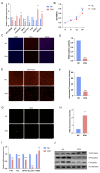tRF-Gly-GCC in Atretic Follicles Promotes Ferroptosis in Granulosa Cells by Down-Regulating MAPK1
- PMID: 39201747
- PMCID: PMC11354299
- DOI: 10.3390/ijms25169061
tRF-Gly-GCC in Atretic Follicles Promotes Ferroptosis in Granulosa Cells by Down-Regulating MAPK1
Abstract
Follicle development refers to the process in which the follicles in the ovary gradually develop from the primary stage to a mature state, and most primary follicles fail to develop normally, without forming a dense granular cell layer and cell wall, which is identified as atretic follicles. Granulosa cells assist follicle development by producing hormones and providing support, and interference in the interaction between granulosa cells and oocytes may lead to the formation of atretic follicles. Ferroptosis, as a non-apoptotic form of death, is caused by cells accumulating lethal levels of iron-dependent phospholipid peroxides. Healthy follicles ranging from 4 to 5 mm were randomly divided into two groups: a control group (DMSO) and treatment group (10 uM of ferroptosis inducer erastin). Each group was sequenced after three repeated cultures for 24 h. We found that ferroptosis was associated with atretic follicles and that the in vitro treatment of healthy follicles with the ferroptosis inducer erastin produced a phenotype similar to that of atretic follicles. Overall, our study elucidates that tRF-1:30-Gly-GCC-2 is involved in the apoptosis and ferroptosis of GCs. Mechanistically, tRF-1:30-Gly-GCC-2 inhibits granulosa cell proliferation and promotes ferroptosis by inhibiting Mitogen-activated protein kinase 1 (MAPK1). tRF-1:30-Gly-GCC-2 may be a novel molecular target for improving the development of atretic follicles in ovarian dysfunction. In conclusion, our study provides a new perspective on the pathogenesis of granulosa cell dysfunction and follicular atresia.
Keywords: MAPK1; atretic follicle; ferroptosis; granular cell; tRF-1:30-Gly-GCC-2.
Conflict of interest statement
The authors declare no conflicts of interest.
Figures






Similar articles
-
Expression of factors involved in apoptosis and cell survival is correlated with enzymes synthesizing lysophosphatidic acid and its receptors in granulosa cells originating from different types of bovine ovarian follicles.Reprod Biol Endocrinol. 2017 Sep 6;15(1):72. doi: 10.1186/s12958-017-0287-9. Reprod Biol Endocrinol. 2017. PMID: 28874163 Free PMC article.
-
Linoleic acid metabolite 13-Hydroxyoctadecadienoic acid as a biphasic ferroptosis modulator in granulosa cells: multi-omics analysis of ovine atretic follicles.Front Cell Dev Biol. 2025 May 30;13:1610621. doi: 10.3389/fcell.2025.1610621. eCollection 2025. Front Cell Dev Biol. 2025. PMID: 40519257 Free PMC article.
-
Preantral follicular atresia occurs mainly through autophagy, while antral follicles degenerate mostly through apoptosis.Biol Reprod. 2018 Oct 1;99(4):853-863. doi: 10.1093/biolre/ioy116. Biol Reprod. 2018. PMID: 29767707
-
Role of programmed cell death in mammalian ovarian follicular atresia.J Steroid Biochem Mol Biol. 2025 Mar;247:106667. doi: 10.1016/j.jsbmb.2024.106667. Epub 2024 Dec 24. J Steroid Biochem Mol Biol. 2025. PMID: 39725276 Review.
-
Follicular atresia in pigs: measurement and physiology.J Anim Sci. 1995 Sep;73(9):2834-44. doi: 10.2527/1995.7392834x. J Anim Sci. 1995. PMID: 8582874 Review.
Cited by
-
Unlocking Resveratrol's Potential: Targeting Ferroptosis in Atherosclerosis Through MAPK1.Food Sci Nutr. 2025 Jul 21;13(7):e70466. doi: 10.1002/fsn3.70466. eCollection 2025 Jul. Food Sci Nutr. 2025. PMID: 40697701 Free PMC article.
-
tsRNA, cell death and disease: Connecting the dots.Noncoding RNA Res. 2025 Apr 29;13:109-120. doi: 10.1016/j.ncrna.2025.04.006. eCollection 2025 Aug. Noncoding RNA Res. 2025. PMID: 40487298 Free PMC article. Review.
-
Metabolomic Analysis Identifies Betaine as a Key Mediator of TAp73α-Induced Ferroptosis in Ovarian Granulosa Cells.Int J Mol Sci. 2025 Jun 24;26(13):6045. doi: 10.3390/ijms26136045. Int J Mol Sci. 2025. PMID: 40649823 Free PMC article.
-
Targeting programmed cell death with natural products: a potential therapeutic strategy for diminished ovarian reserve and fertility preservation.Front Pharmacol. 2025 May 29;16:1546041. doi: 10.3389/fphar.2025.1546041. eCollection 2025. Front Pharmacol. 2025. PMID: 40510420 Free PMC article. Review.
-
hnRNPA2B1 restrains granulosa cell ferroptosis by m6A/SLC7A11 in premature ovarian failure.J Ovarian Res. 2025 Jul 26;18(1):165. doi: 10.1186/s13048-025-01718-y. J Ovarian Res. 2025. PMID: 40713667 Free PMC article.
References
-
- Gougeon A. Some aspects of the dynamics of ovarian follicular growth in the human. Acta Eur. Fertil. 1989;20:185–192. - PubMed
MeSH terms
Substances
Grants and funding
- 2021YFD1200801/National Key Research and Development Program of China
- 2021YFYZ0007, 2021YFYZ0030, 24NSFSC4918, sccxtd-2024-08-09/Sichuan Science and Technology Program
- CARS-35/China Agriculture Research System
- 2023M732514/China Postdoctoral Science Foundation
- GZC20231860/Postdoctoral Fellowship Program of CPSF
LinkOut - more resources
Full Text Sources
Miscellaneous

